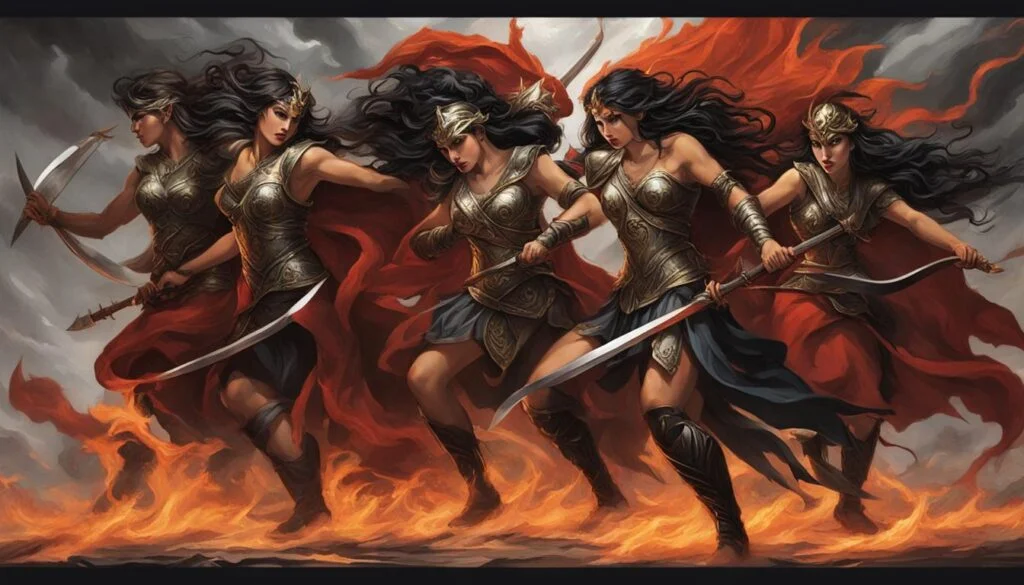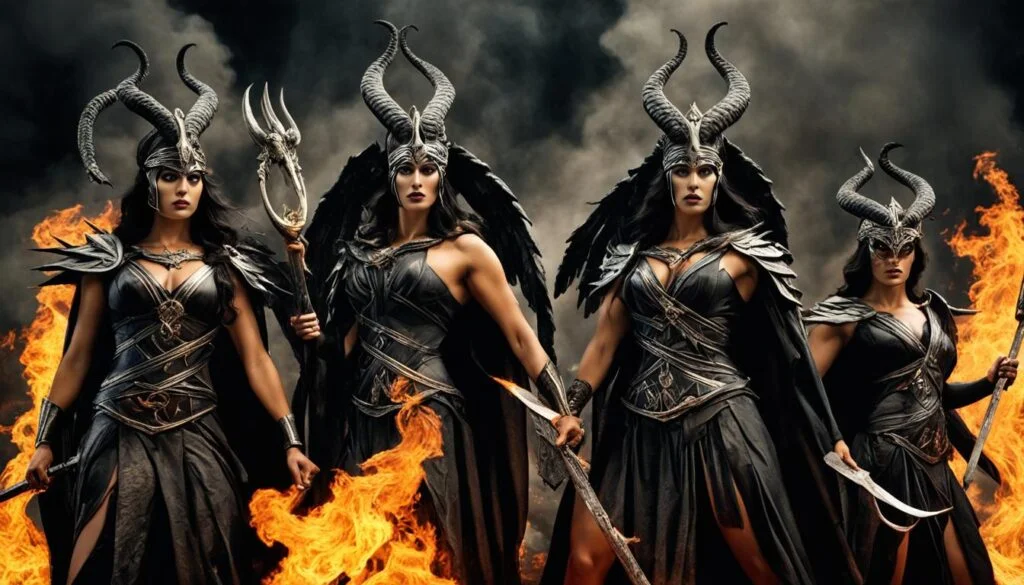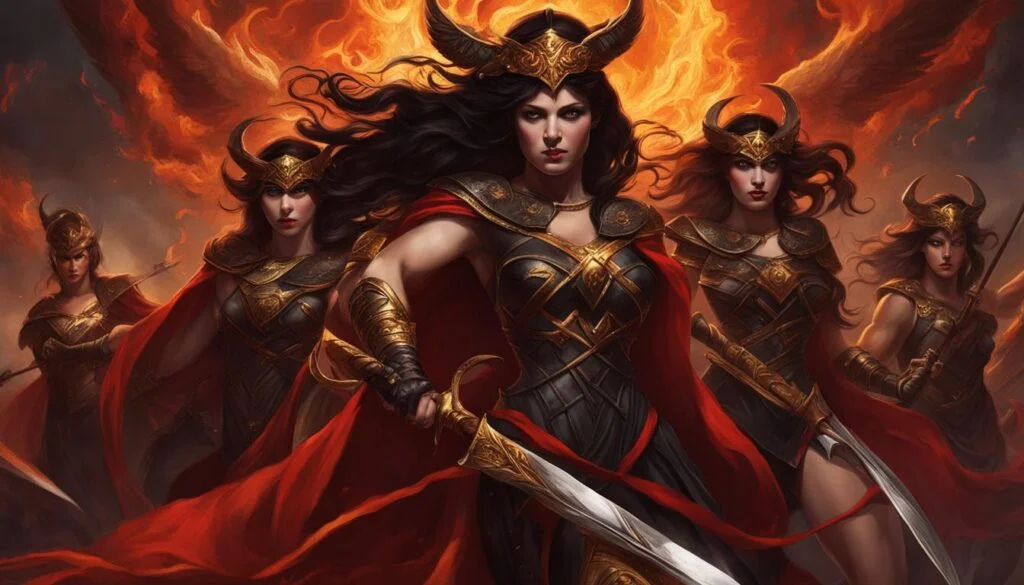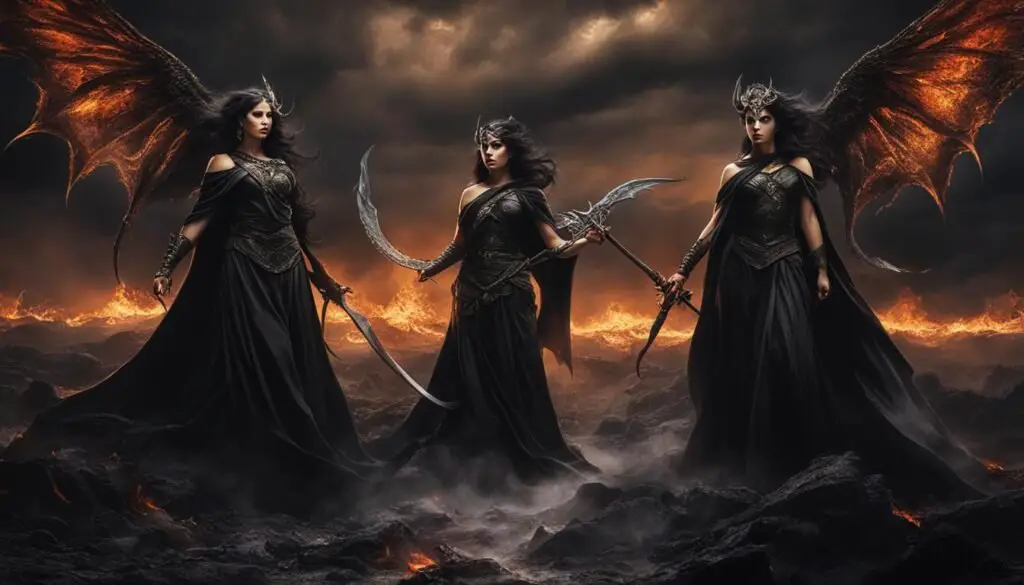In Greek mythology, the Furies, also known as the Erinyes, were powerful female deities associated with vengeance and retribution. These mythological creatures were the embodiment of justice, and their fierce appearance struck fear into the hearts of mortals. Let’s delve deeper into the fascinating world of the Furies in Greek mythology.
Key Takeaways:
- The Furies, or Erinyes, were Greek goddesses of vengeance and justice.
- They were mythological creatures who punished those who committed crimes.
- Their origins varied, with different myths attributing their creation to the blood of Uranus and Gaea, the darkness of Nyx, or as children of Gaea and Darkness.
- The Furies had distinctive appearances, with snakes in their hair, bat wings, and bloodshot eyes.
- They played significant roles in mythological stories, such as the Oresteia, where they transformed from vengeful beings to defenders of justice.
Symbols and Appearance of the Furies
In Greek mythology, the Furies were powerful female deities associated with vengeance and retribution. The symbols and appearance of the Furies conveyed their terrifying nature.
The Furies were often depicted with snakes in their hair and wrapped around their arms. These snakes symbolized their connection to the underworld and the darkness within them. Their presence served as a grim reminder of the consequences awaiting those who cross the boundaries of morality.
Another distinctive feature of the Furies was their bat wings, which enabled them to move swiftly between the realms of the living and the dead. These wings, along with their bloodshot eyes, created an eerie and intimidating appearance.
Additionally, the Furies were always depicted wearing all black clothing. This further emphasized their association with darkness, death, and the somber nature of their purpose.
To enforce their harsh justice, the Furies carried whips adorned with brass studs. These whips were used as instruments of punishment, inflicting pain upon those who had committed crimes.
The symbolic elements and appearance of the Furies beautifully represented their role as agents of vengeance and justice in Greek mythology.
Names and Roles of the Furies

The Furies, also known as the Erinyes, were referred to by different names, each reflecting their role and significance in Greek mythology. These names were often used to avoid speaking their real name, as they were feared and respected by both mortals and gods.
Erinyes, meaning ‘strife’, represented the relentless anger and retribution that accompanied acts of wrongdoing. Their wrath was swift and unyielding.
Eumenides, translated as ‘kindly’, may seem contradictory at first. However, it reflects the Furies’ role as purveyors of justice and their ability to bring peace and resolution to those who sought their guidance.
Semnai, meaning ‘August’, denoted their revered status as divine enforcers. The Furies were respected for their power and authority, embodying the August personification of justice and retribution.
Among the Furies, three stood out with distinct roles:
- Alecto embodied unbridled anger and was responsible for punishing moral and social transgressions.
- Megaera symbolized jealousy and was tasked with avenging broken oaths and betrayals.
- Tisiphone represented the spirit of revenge and was responsible for exacting retribution on murderers and those who had escaped punishment.
Each Fury played a crucial role in maintaining order and ensuring that justice prevailed in the mortal realm.
The Furies:
- Erinyes
- Eumenides
- Semnai
The Roles of the Furies:
- Alecto – Anger
- Megaera – Jealousy
- Tisiphone – Avenging
Origins and Creation of the Furies

The origins of the Furies in Greek mythology are diverse and varied, depending on the different myths and interpretations. According to some versions, the Furies were born from the blood of Uranus, the god of the sky, and Gaea, the mother Earth. It is said that after Uranus’s death, Gaea collected his blood and created the Furies as powerful goddesses of vengeance and retribution. This association with the blood of Uranus and Gaea emphasizes their connection to the primal forces of the universe.
In other stories, the Furies are described as the children of Gaea and Darkness, suggesting that their creation is rooted in the darkness and chaos that existed before the world was formed. This connection to Darkness further enhances their ominous and mysterious nature.
Additionally, some myths refer to the Furies as the daughters of Nyx, the goddess of night. This lineage reinforces their association with the underworld and the realm of darkness, where the goddess Nyx holds sway. It is in this domain that the Furies carry out their role as enforcers of justice.
The diverse origins of the Furies contribute to their enigmatic nature and their unique place in Greek mythology. Born from cosmic forces and connected to the earth, darkness, and night, the Furies embody the primal and powerful aspects of the human psyche. Their creation reflects the ancient Greeks’ understanding of the complex dynamics of the world and the fundamental forces at play.
The Furies in Mythological Stories

In Greek mythology, the Furies, also known as the Erinyes, were not only powerful deities associated with vengeance and justice, but they also played a significant role in many mythological stories. One such story is the trilogy Oresteia by Aeschylus, which revolves around the aftermath of the Trojan War for King Agamemnon and his family.
After Agamemnon sacrificially offered their daughter, Iphigenia, to the gods, his wife, Clytemnestra, seeks revenge and kills him. Clytemnestra’s ghost then appeals to the Furies to avenge her, leading to a relentless chase of her son, Orestes, to Athens. Orestes is tormented by the Furies, who represent the consequences of his mother’s actions and demand his punishment.
Fortunately, the goddess Athena intervenes in the conflict. Taking into account the complexity of the situation, she convinces the Furies to spare Orestes and turns their role from instruments of vengeance to protectors of justice. This transformative event marks a noteworthy shift in the Furies’ portrayal, portraying them as defenders of righteous acts and the order in society.
The inclusion of the Furies in the Oresteia showcases their integral role in ancient Greek mythology, highlighting their representation of the cyclical nature of vengeance and the pursuit of justice. It also underscores the significant involvement of both Orestes and Clytemnestra in the intricate narrative, challenging the boundaries of familial love and retribution.
Throughout various mythological stories, the Furies demonstrate their unique power and influence, leaving an indelible mark on the cultural and mystical landscape.
Significance and Cultural Impact of the Furies

The Furies, also known as the Erinyes, held immense cultural and psychological importance in ancient Greek society. Their haunting appearance and association with vengeance struck fear into the hearts of the people, and even uttering their names was considered taboo. But beyond their fearsome reputation, the Furies left a profound impact on art, literature, and the collective imagination of the Greeks.
In ancient Greek culture, the Furies were often depicted in various forms of artistic expression. They appeared in sculptures, pottery, and murals, showcasing their terrifying presence and striking features. These artistic representations not only served as visual reminders of the consequences of immoral acts but also reinforced the idea that justice would prevail.
Literature also played a significant role in preserving the legacy of the Furies. In Virgil’s Aeneid, the Furies are portrayed as terrifying and relentless guardians of moral order. They punish those who have committed heinous crimes, ensuring that justice is served. Similarly, Dante’s Divine Comedy features the Furies as manifestations of divine justice. They oversee punishments in the depths of hell, further emphasizing their role as agents of retribution.
Through these symbolic representations in art and literature, the Furies became deeply ingrained in Greek mythology and cultural consciousness. Their presence served as a reminder of the consequences of wrongdoing, instilling a sense of fear and moral responsibility in society.
The image above captures the essence of the Furies’ significance in ancient Greek culture. With their snake-entwined hair, bat wings, and fierce expressions, they embody the fearsome nature of these divine entities.
The Furies’ cultural impact extended beyond ancient Greece, influencing later societies and artistic traditions. Their portrayal as embodiments of justice and retribution resonates with themes explored in countless works of literature and art throughout history.
The Fear of the Furies
The fear of the Furies was not limited to ancient times but continues to captivate and unsettle people. Even today, their powerful and ominous presence serves as a reminder of the consequences of acting against moral order and justice.
The symbolic representations of the Furies in art and literature carry a universal message that transcends time and culture. They remind us that actions have consequences and that justice will prevail, even if it is delivered in a form as terrifying as the Furies themselves.
Conclusion
The Furies, or Erinyes, in Greek mythology were powerful goddesses of vengeance and justice. They symbolized the consequences of immoral acts and played prominent roles in mythological stories like the Oresteia.
The Furies were associated with snakes, blood, and bat wings, emphasizing their intimidating appearance. Their origins varied in different myths, but they were always connected to the earth and the underworld. Despite their fearsome reputation, the Furies served an important role in maintaining justice and order in the divine hierarchy.
Throughout Greek mythology, the Furies stood as powerful beings, ensuring consequences for those who committed wrongful acts. Their association with snakes, blood, and bat wings added to their enigmatic aura. Whether born from the blood of Uranus and Gaea or the darkness of Nyx, the Furies remained connected to the earth and the underworld, serving as guardians of just punishment.
Despite their fearsome appearance and reputation, the Furies played a critical role in maintaining order and justice. Their presence served as a cautionary reminder for mortals to consider the consequences of their actions. By embodying vengeance and retribution, the Furies ensured a balance in the divine hierarchy and symbolized the eternal consequences of immoral acts in Greek mythology.
FAQ
What is the origin of the Furies in Greek mythology?
The Furies had different origins in different myths, including being born from the blood of Uranus and Gaea, or the darkness of Nyx. Some versions also suggest they were the children of Gaea and Darkness.
What do the Furies symbolize in Greek mythology?
The Furies symbolize vengeance and justice. They were associated with the consequences of immoral acts and were feared for their role in punishing those who had committed crimes.
What is the appearance of the Furies?
The Furies were depicted as hags with snakes in their hair, blood dripping from their eyes, and bat wings. They wore all black and carried whips with brass studs.
What were the names and roles of the Furies?
The Furies were referred to by names such as the Erinyes, Eumenides (kindly), or Semnai (August). Alecto represented anger, Megaera represented jealousy, and Tisiphone represented avenging. Each Fury had a specific role in punishing those who had committed crimes.
What was the role of the Furies in the Oresteia?
In the Oresteia by Aeschylus, the Furies chased Orestes to Athens after he avenged his father’s death. Athena intervenes and convinces the Furies to spare Orestes, leading to their transformation into the “Venerated Ones.” This event marked a shift in their role from vengeance to defenders of justice.
How did the Furies impact ancient Greek culture?
The Furies were feared and respected, with their names considered taboo. They held significant cultural and psychological importance, symbolizing the consequences of immoral acts. The Furies appeared in art and literature, leaving a lasting impact on Greek mythology.




